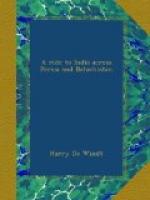Proceeding homewards, we had scarcely reached camp when a terrific thunderstorm burst over our heads. The thunderclaps were in some instances nearly a minute in duration, and the lightning unpleasantly close and vivid.
The weather clearing, I visited the bazaar in the evening, under the guidance of my old friend, the Wazir. Trade is, as I have said, practically nil in Beila, and the manufactures, which are trifling, are confined to oil, cotton, a rough kind of cloth, and coarse carpets; indeed, throughout the country, commerce is almost at a standstill.
This is scarcely surprising when the semi-savage state of the people, and consequent risks to life and property, are taken into account. The export trade of the interior is, though trifling at present, capable, under firm and wise rule, of great improvement. Madder, almonds, and dried fruit from Kelat and Mastung, seed and grain from Khozdar, small quantities of assa-foetida from Nushki, and sulphur from Kach-Gandava, comprise all the exports. From Mekran and Las Beila are exported “rogan,” or clarified butter used for cooking purposes, hides, tobacco (of a very coarse kind), salt fish, oil-seeds, and dates. The imports chiefly consist of rice, pepper, sugar, spices, indigo, wood, and piece goods, chiefly landed at the ports of Gwadar or Sonmiani. But little is as yet known of the mineral products of this district. Iron ore is said to exist in the mountains north of Beila, while to the south copper is reported as being found in large quantities; but nothing has as yet been done to open up the mineral resources of the district. Although silver and even gold have been found in small quantities, and other minerals are known to exist, the only mines at present in Baluchistan are those near Khozdar, in the province of Jhalawan, where lead and antimony are worked, but in a very primitive manner.
Notwithstanding the trade stagnation, there seems to be a good deal of cultivation in and around Beila. Water is obtained from deep wells; and vegetables, rice, and tobacco are largely grown. Most of the stalls in the bazaar were devoted to the sale of rice, wheat, and tobacco, cheap cutlery, and Manchester goods; and I noticed, with some surprise, cheap photographs of Mrs. Langtry, Ellen Terry, Miss Nelly Farren, Sylvia Grey, and other leading lights of society and art, spread out for sale among the many-bladed knives, nickel forks and spoons, and German timepieces. Although the narrow alleys reeked with poisonous smells and filth and abomination of all kinds, Beila is not unhealthy—so at least the Wazir informed me. I doubted the truth of this assertion, however, for the features of every second person I met were scarred more or less with small-pox.




